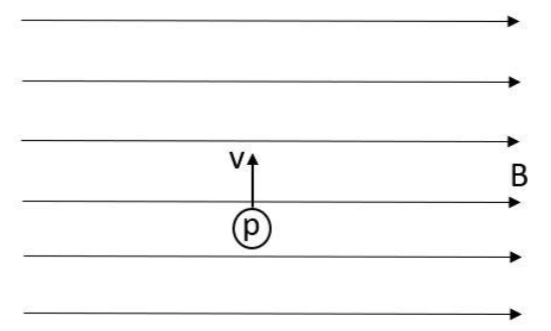Answer
424.2k+ views
Hint: By using the formula of force acting on the particle and its kinetic energy, we will find out the relation for the force with the given values, and then upon calculation, we will get the desired result.
Formula used:
F = qvB
$K_e =\dfrac{1}{2}mv^2$
Complete step by step answer:
The given situation can be illustrated as follows:

Now, from the given question, we can find the force on the proton using the conservation of energy.
We know that the mass of a proton is
${{\text{M}}_{\text{p}}}\text{ = 1}\text{.6 }\times \text{ 1}{{\text{0}}^{-27}}\text{ kg}$
And the charge in a single proton is
$e\text{ = 1}\text{.6 }\times \text{ 1}{{\text{0}}^{-19}}\text{ C}$
Further,
From energy conservation theory, we know that the formula of Force is
$\text{F = qvB }\ldots \text{(i)}$
Where,
F = force
q = electric charge
v = velocity
B = magnetic field
We also know,
The formula for kinetic energy is
$\dfrac{\text{m}{{\text{v}}^{2}}}{\text{2}}\text{=}{{\text{K}}_{\text{e}}}\text{ }\ldots \text{(ii)}$
Where,
${{\text{K}}_{\text{e}}}$ = kinetic energy
v = velocity
m = mass of body
Equating both equations (i) and (ii) with respect to v, we get,
$\text{v = }\sqrt{\dfrac{2{{\text{K}}_{\text{e}}}}{\text{m}}}$
Now,
Since we know the value of v,
$\therefore \text{ f = q }\times \text{ }\sqrt{\dfrac{2{{\text{K}}_{\text{e}}}}{\text{m}}}\text{ }\times \text{ B}$
By equating this we get,
$\text{f = 1}\text{.6 }\times \text{ 1}{{\text{0}}^{-\text{19}}}\text{ }\times \text{ }\sqrt{\dfrac{2\text{ }\times \text{ 2 }\times \text{ 1}{{\text{0}}^{\text{6}}}\text{ }\times \text{ 1}\text{.6 }\times \text{ 1}{{\text{0}}^{-19}}}{\text{1}\text{.6 }\times \text{ 1}{{\text{0}}^{-\text{27}}}}}\text{ }\times \text{ 2}\text{.5}$
$=\text{ 8 }\times \text{ 1}{{\text{0}}^{-\text{12}}}\text{ N}$
Therefore, the correct option is Option D.
Note: Since the charge on proton inside an atom is always positive, and that of an electron is always negative, the overall charge of an atom is neutral. This happens because of the same number of protons and the electrons cancel each other. It should also be known to us that the charge on the proton is because of the quarks that make up the nucleons. By the nucleons, we mean the protons and the neutrons both taken into consideration at the same time.
Formula used:
F = qvB
$K_e =\dfrac{1}{2}mv^2$
Complete step by step answer:
The given situation can be illustrated as follows:

Now, from the given question, we can find the force on the proton using the conservation of energy.
We know that the mass of a proton is
${{\text{M}}_{\text{p}}}\text{ = 1}\text{.6 }\times \text{ 1}{{\text{0}}^{-27}}\text{ kg}$
And the charge in a single proton is
$e\text{ = 1}\text{.6 }\times \text{ 1}{{\text{0}}^{-19}}\text{ C}$
Further,
From energy conservation theory, we know that the formula of Force is
$\text{F = qvB }\ldots \text{(i)}$
Where,
F = force
q = electric charge
v = velocity
B = magnetic field
We also know,
The formula for kinetic energy is
$\dfrac{\text{m}{{\text{v}}^{2}}}{\text{2}}\text{=}{{\text{K}}_{\text{e}}}\text{ }\ldots \text{(ii)}$
Where,
${{\text{K}}_{\text{e}}}$ = kinetic energy
v = velocity
m = mass of body
Equating both equations (i) and (ii) with respect to v, we get,
$\text{v = }\sqrt{\dfrac{2{{\text{K}}_{\text{e}}}}{\text{m}}}$
Now,
Since we know the value of v,
$\therefore \text{ f = q }\times \text{ }\sqrt{\dfrac{2{{\text{K}}_{\text{e}}}}{\text{m}}}\text{ }\times \text{ B}$
By equating this we get,
$\text{f = 1}\text{.6 }\times \text{ 1}{{\text{0}}^{-\text{19}}}\text{ }\times \text{ }\sqrt{\dfrac{2\text{ }\times \text{ 2 }\times \text{ 1}{{\text{0}}^{\text{6}}}\text{ }\times \text{ 1}\text{.6 }\times \text{ 1}{{\text{0}}^{-19}}}{\text{1}\text{.6 }\times \text{ 1}{{\text{0}}^{-\text{27}}}}}\text{ }\times \text{ 2}\text{.5}$
$=\text{ 8 }\times \text{ 1}{{\text{0}}^{-\text{12}}}\text{ N}$
Therefore, the correct option is Option D.
Note: Since the charge on proton inside an atom is always positive, and that of an electron is always negative, the overall charge of an atom is neutral. This happens because of the same number of protons and the electrons cancel each other. It should also be known to us that the charge on the proton is because of the quarks that make up the nucleons. By the nucleons, we mean the protons and the neutrons both taken into consideration at the same time.
Recently Updated Pages
How many sigma and pi bonds are present in HCequiv class 11 chemistry CBSE

Why Are Noble Gases NonReactive class 11 chemistry CBSE

Let X and Y be the sets of all positive divisors of class 11 maths CBSE

Let x and y be 2 real numbers which satisfy the equations class 11 maths CBSE

Let x 4log 2sqrt 9k 1 + 7 and y dfrac132log 2sqrt5 class 11 maths CBSE

Let x22ax+b20 and x22bx+a20 be two equations Then the class 11 maths CBSE

Trending doubts
Fill the blanks with the suitable prepositions 1 The class 9 english CBSE

At which age domestication of animals started A Neolithic class 11 social science CBSE

Which are the Top 10 Largest Countries of the World?

Give 10 examples for herbs , shrubs , climbers , creepers

Difference between Prokaryotic cell and Eukaryotic class 11 biology CBSE

Difference Between Plant Cell and Animal Cell

Write a letter to the principal requesting him to grant class 10 english CBSE

Change the following sentences into negative and interrogative class 10 english CBSE

Fill in the blanks A 1 lakh ten thousand B 1 million class 9 maths CBSE



